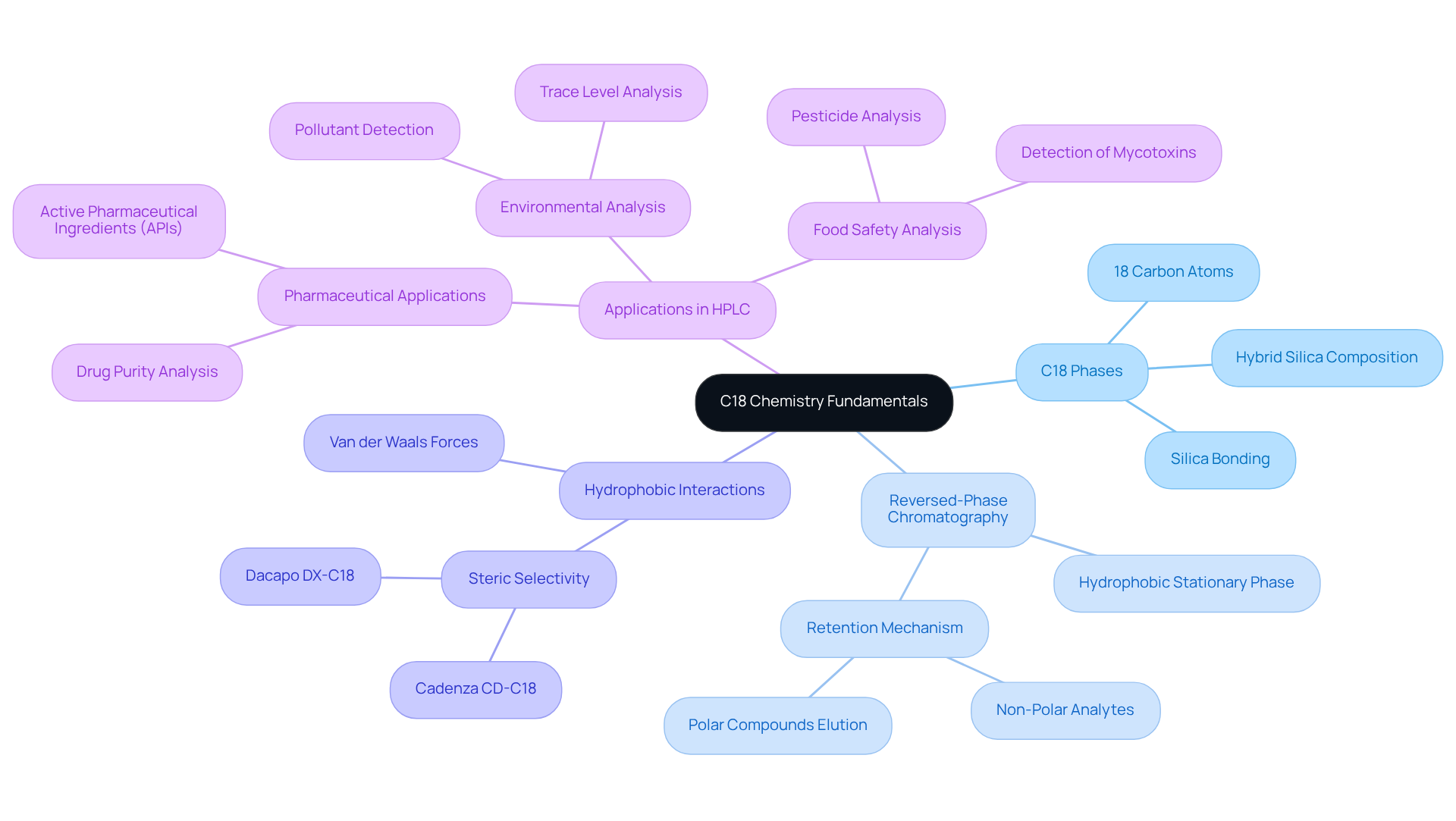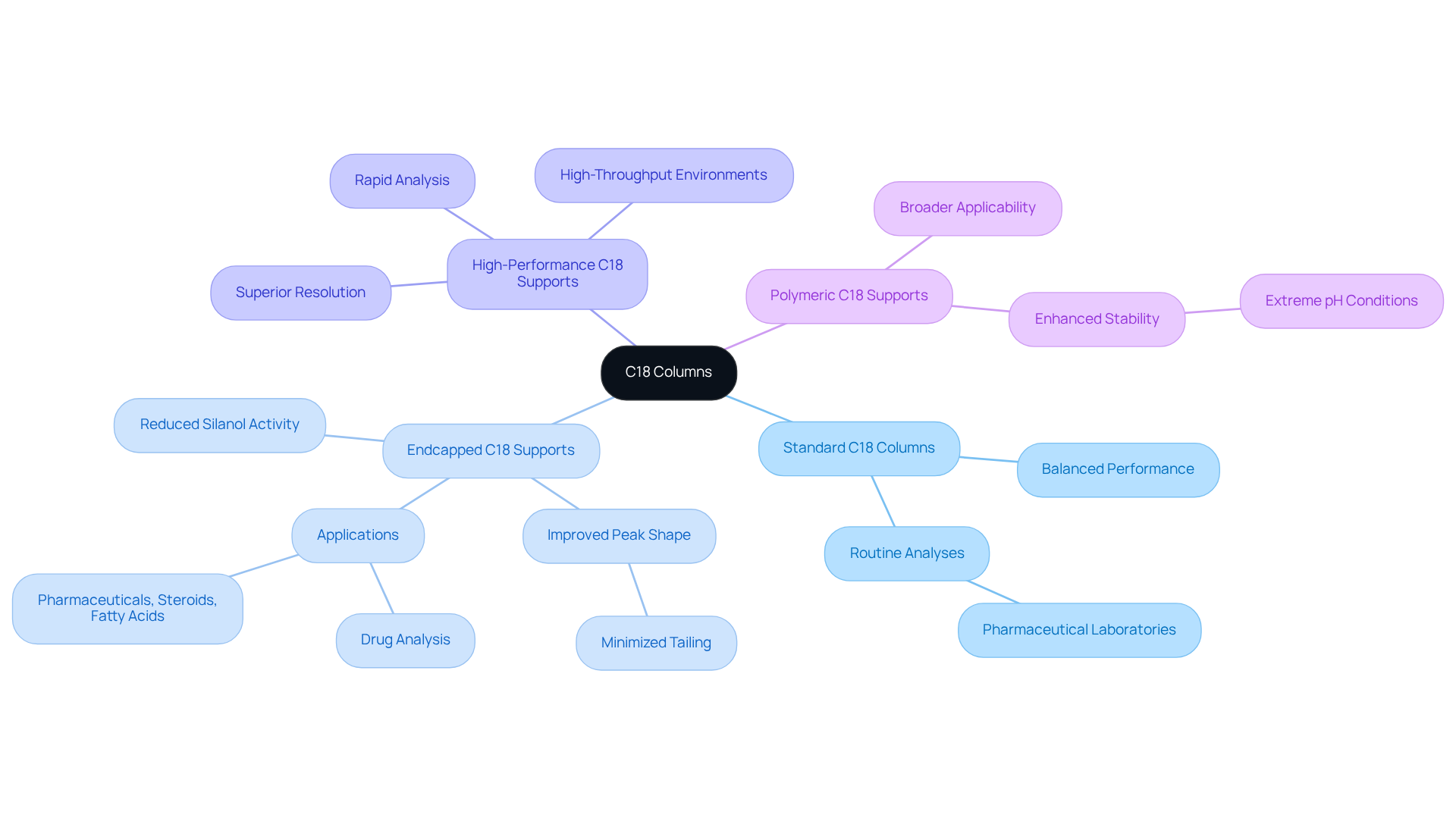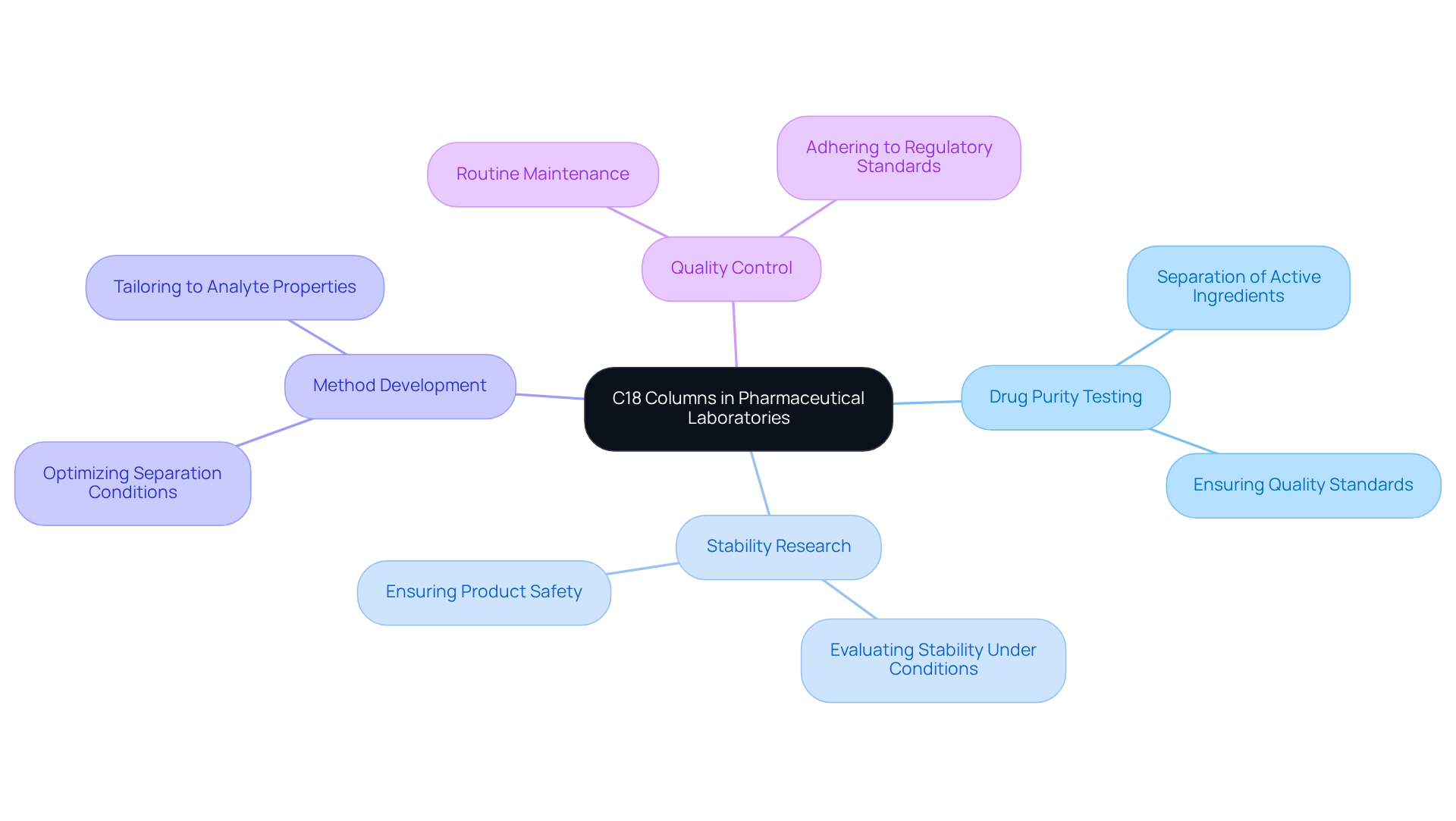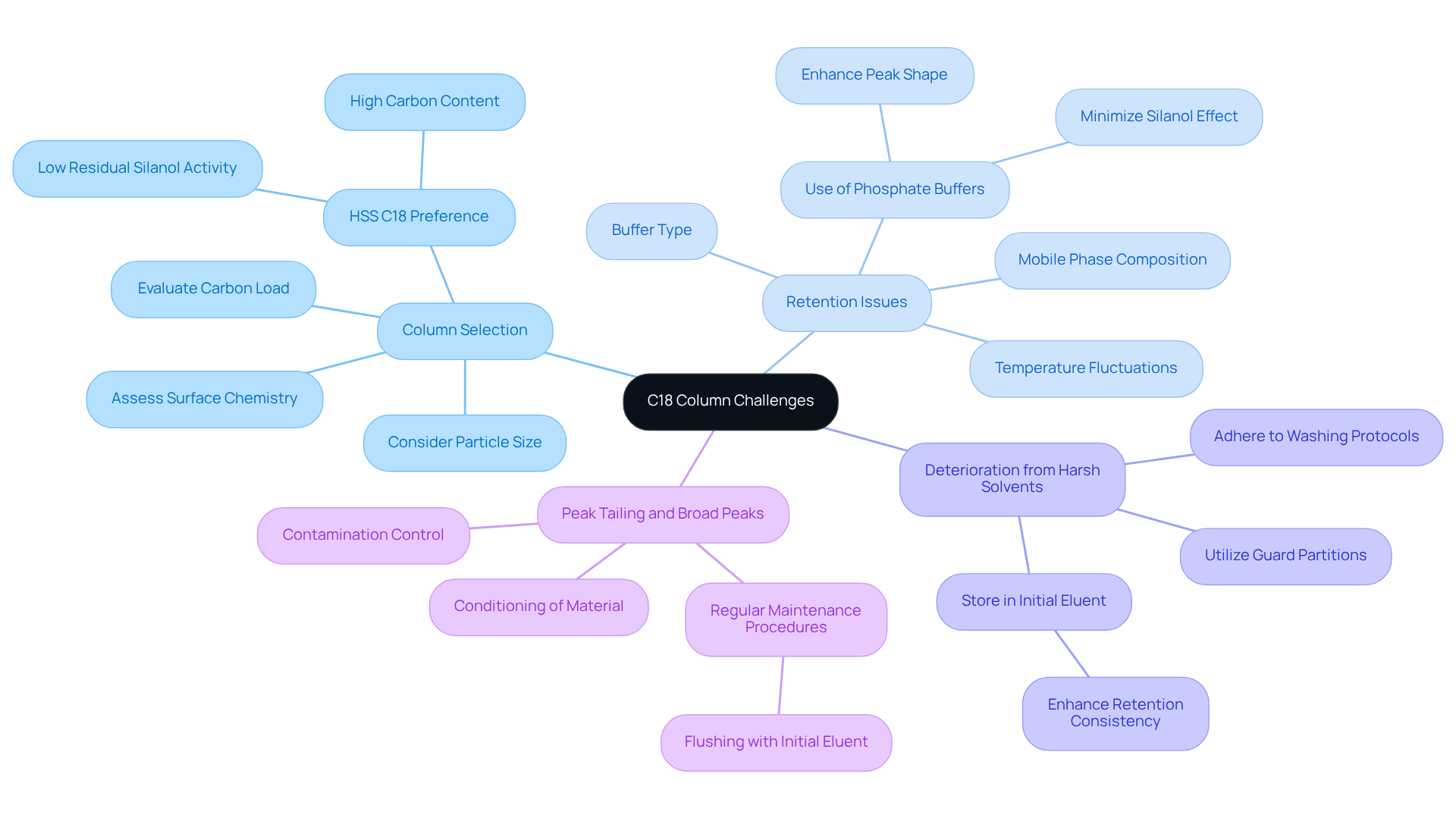Overview
C18 chemistry plays a pivotal role in pharmaceutical laboratories, enabling the effective separation of non-polar compounds through reversed-phase chromatography. This process is crucial for ensuring drug purity, conducting stability research, and developing reliable methods.
By understanding the characteristics and applications of various C18 columns, laboratories can enhance their analytical precision and efficiency. This understanding is essential for meeting stringent quality standards in pharmaceutical products, thereby reinforcing the integrity of the industry.
Introduction
C18 chemistry stands as a cornerstone in the field of pharmaceutical laboratories, underpinning the principles of reversed-phase chromatography. By harnessing the distinctive properties of octadecylsilane phases, professionals can achieve precise separation of compounds based on their hydrophobic characteristics—an essential factor in ensuring drug purity and efficacy.
Nevertheless, the intricacies involved in selecting and maintaining C18 columns present notable challenges. How can laboratory experts optimize their utilization of C18 chemistry to enhance analytical accuracy while effectively navigating these complexities?
Explore C18 Chemistry Fundamentals
C18 chemistry, which includes octadecylsilane phases, is a crucial component of reversed-phase chromatography utilized extensively in high-performance liquid chromatography (HPLC). The term 'C18' signifies the presence of 18 carbon atoms in the alkyl chain bonded to the silica surface. This hydrophobic stationary phase exhibits strong interactions with non-polar compounds, facilitating effective separation based on hydrophobicity.
The fundamental principle of C18 chemistry in chromatography is that non-polar analytes preferentially associate with the hydrophobic C18 chains, leading to their retention within the system, while polar compounds elute more rapidly. A comprehensive understanding of these interactions is essential for optimizing separation conditions, thereby ensuring accurate analytical results in pharmaceutical applications.

Identify Types and Characteristics of C18 Columns
C18 chemistry involves indispensable materials in chromatography, which are categorized by key factors such as particle size, pore size, and surface chemistry. Understanding these categories is crucial for laboratory professionals in C18 chemistry who are seeking to optimize their analytical processes. The primary types include:
- Standard C18 Columns: These columns dominate laboratory settings, providing a balanced performance regarding retention and resolution across a diverse range of analytes. Their effectiveness makes them particularly suitable for routine analyses in pharmaceutical laboratories.
- Endcapped C18 Supports: Enhanced with additional chemical modifications, these supports significantly reduce silanol activity, leading to improved peak shape and minimized tailing, especially for basic compounds. This feature is vital in drug analysis, where precision is critical. C18 chemistry materials that are endcapped find practical application in the analysis of pharmaceuticals, steroids, and fatty acids, ensuring accurate results in complex matrices.
- High-Performance C18 Supports: Engineered for rapid analysis and superior resolution, these supports utilize smaller particle sizes and refined surface chemistry, making them ideal for high-throughput environments.
- Polymeric C18 Supports: Constructed from polymeric materials instead of traditional silica, these supports exhibit enhanced stability under extreme pH conditions, thus broadening their applicability in various analytical scenarios.
C18 materials typically operate within a pH range of 1 to 12, which is essential for maintaining their effectiveness across different analytical contexts. Their multi-layer structure, comprising both inorganic silica and organic polymer layers, contributes to their durability and outstanding performance under low-pressure conditions. By understanding the distinctions among these types of columns, laboratory experts can make informed decisions to select the most suitable C18 chemistry option for their specific analytical requirements, ultimately improving the efficiency and precision of their drug analysis procedures.

Apply C18 Columns in Pharmaceutical Laboratories
In pharmaceutical laboratories, C18 chemistry is indispensable for several key applications. First, they excel in drug purity testing, effectively separating active ingredients from impurities to ensure that products meet stringent quality standards. In addition, these columns are essential for stability research, evaluating the stability of pharmaceutical compounds under varying environmental conditions. This evaluation is crucial for ensuring product safety and effectiveness over time. Furthermore, C18 columns serve as versatile tools in method development, enabling the optimization of separation conditions tailored to the specific properties of the analytes involved. Lastly, their regular utilization in quality control processes is vital for guaranteeing that pharmaceutical products adhere to regulatory standards and specifications.
C18 chemistry columns represent the most commonly used form of HPLC apparatus, making their proper usage critical in pharmaceutical applications. To enhance the efficiency of C18 phases, optimizing mobile phase composition, flow rates, and temperature conditions based on the specific analytes being examined is essential. Moreover, employing HPLC-grade organic solvents and high-purity water is crucial for ensuring optimal functionality. Routine upkeep, including flushing tainted sections with pure acetonitrile and pre-use activation, is necessary for guaranteeing steady performance and durability.

Navigate Challenges in C18 Column Selection and Use
Navigating the challenges associated with C18 chemistry is crucial for achieving reliable chromatographic results. Key considerations include:
-
Column Selection: Selecting from the vast array of C18 columns can be overwhelming. It is essential to evaluate factors such as carbon load, particle size, and surface chemistry tailored to specific applications. For instance, the C18 chemistry phase known as HSS C18, recognized for its high carbon content and low residual silanol activity, is often preferred for its selectivity for basic compounds, as highlighted in recent studies.
-
Retention Issues: Variability in retention times can arise from mobile phase composition, buffer type, and temperature fluctuations. Studies indicate that using phosphate buffers at low pH can enhance peak shape and retention times by minimizing the silanol effect. Regular calibration and method validation are vital to effectively address these issues, particularly by leveraging the benefits of low pH phosphate buffers.
-
Deterioration from Harsh Solvents: C18 chemistry shows that C18 types are susceptible to deterioration from harsh solvents and improper storage. Optimal methods, such as utilizing guard partitions and adhering to suitable washing protocols, can significantly extend the lifespan of the structures. Research suggests that keeping sections in the initial eluent overnight can enhance inter-day retention consistency, offering a practical method for sustaining effectiveness.
-
Peak Tailing and Broad Peaks: These common problems often occur due to insufficient conditioning of the material or contamination. Establishing regular maintenance and cleaning procedures is vital for optimal functioning. For instance, flushing the section with the initial eluent prior to storage can assist in maintaining performance and decreasing peak asymmetry, ensuring reliable results.
By comprehensively understanding these challenges and employing effective strategies, laboratory professionals can significantly enhance the reliability and accuracy of their analyses by utilizing C18 chemistry with C18 columns.

Conclusion
C18 chemistry is indispensable in the realm of pharmaceutical analysis, particularly through its application in reversed-phase chromatography. By harnessing the unique properties of C18 columns, laboratories can achieve effective separation and precise characterization of complex pharmaceutical compounds. A comprehensive understanding of C18 chemistry not only elevates analytical precision but also ensures adherence to rigorous quality standards throughout drug development and testing.
This article has delved into essential insights regarding C18 column types, their characteristics, and specific applications. From standard and endcapped columns to high-performance and polymeric supports, each type presents distinct advantages tailored to meet various analytical requirements. Furthermore, addressing challenges such as column selection, retention issues, and peak performance is crucial for optimizing the utilization of C18 columns in pharmaceutical laboratories. Regular maintenance and strategic selection of mobile phase conditions significantly enhance the reliability of analytical results.
In summary, mastering C18 chemistry is vital for professionals operating within pharmaceutical laboratories. By prioritizing a thorough understanding of C18 column properties and best practices, laboratories can markedly enhance their analytical capabilities. Embracing this knowledge not only streamlines effective drug analysis but also underscores the critical role of quality control in ensuring the safety and efficacy of pharmaceutical products.




